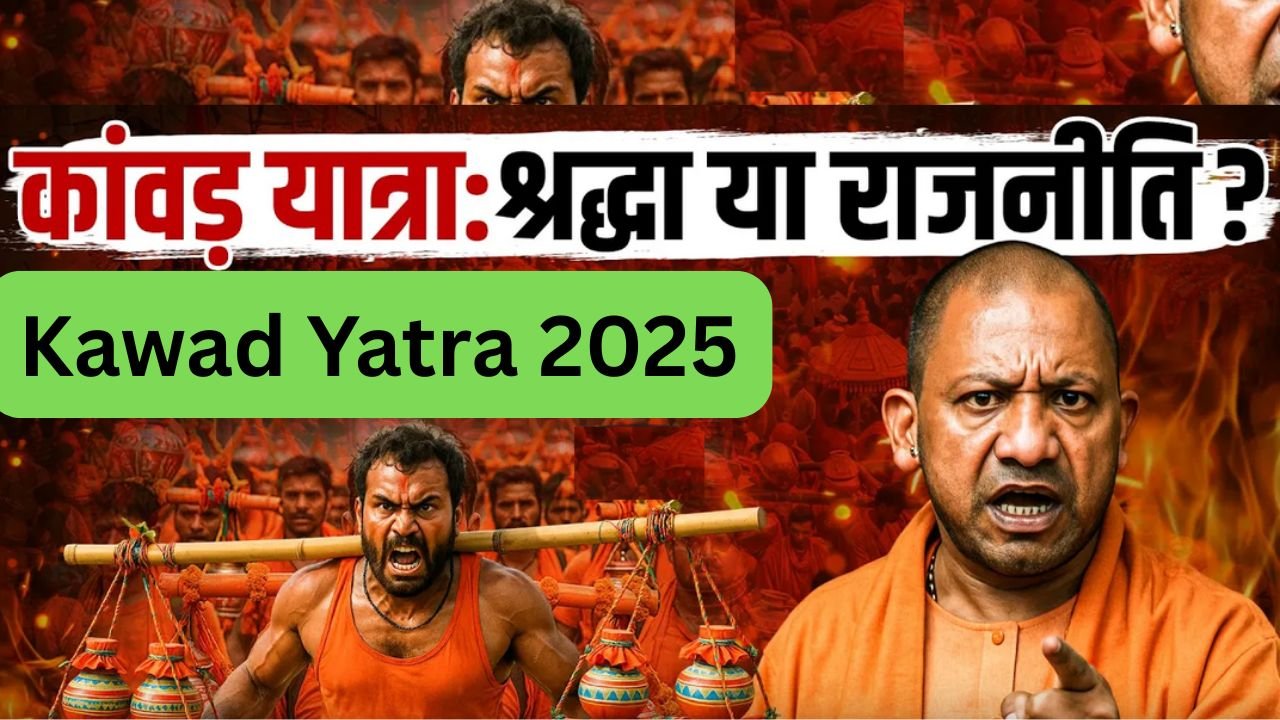Kawad Yatra 2025: What Does Religion Teach Us?
Religion, at its core, teaches peace, compassion, and devotion. But when these values are replaced by aggression, political agendas, and disruption of public life, questions arise about the true nature of such expressions of faith. As the country prepares for Kawad Yatra 2025, concerns are resurfacing—concerns about safety, communal tension, and the politicization of religious sentiment.
Table of Contents
A recent report by the Centre for Study of Society and Secularism (CSSS) revealed an 84% spike in communal violence in India during 2024. This has put religious events like Kawad Yatra 2025 under scrutiny, especially after several violent incidents were linked to it in previous years.
Kawad Yatra: Roots in Devotion, Not Aggression
Kawad Yatra is traditionally a pilgrimage where Lord Shiva’s devotees (known as Kawadiyas) carry holy water from rivers—most notably the Ganga—to offer it at Shiva temples. Mythologically, its origins are linked to divine figures like Parashuram, Lord Ram, and Shravan Kumar. These stories emphasize sacrifice, discipline, and faith.
However, the form of the event today—particularly in North India—has diverged sharply from these ideals. What began as a peaceful spiritual journey is now increasingly becoming a spectacle of dominance, often marred by unruly crowds, road blockages, and even violence.
Kawad Yatra 2025: More Security, More Questions
Kawad Yatra 2025 is anticipated to be larger than ever. In preparation, authorities have deployed massive paramilitary forces across Haridwar, Delhi, and other pilgrimage routes. The security arrangement includes:
CRPF (2 companies)
BSF (1 company)
ITBP (2 companies)
SSB (3 companies)
RAF (5 companies)
PAC (5 companies)
Zones have been strategically divided—Haridwar, Roorkee, and Dehradun—to better manage the crowd. Despite these measures, past years saw disturbing trends: paramilitary deployment outside tent cities, violent clashes with traffic police, and vandalism by aggressive groups of devotees.
In one such incident, a woman traffic constable was attacked by a group of Kawadiyas in Haridwar. She was hospitalized in critical condition. Such episodes have led many to ask: Is Kawad Yatra 2025 really about faith anymore, or has it become a symbol of unchecked street power?
The Politics of Faith: Vote Banks and Violent Devotion
Over the past decade, there has been a visible politicization of Kawad Yatra. Right-wing organizations and local political players have turned what was once a devotional journey into a politically sponsored show of strength. In many cases, local sponsors fund the travel, lodging, and food for thousands of unemployed youth—mainly from backward or Dalit communities—encouraging them to participate. These “sponsored” pilgrims can later be mobilized for political rallies, protests, or even riots.
During Kawad Yatra 2025, similar strategies are expected to be used. Political figures often provide these groups with a VIP treatment: free food, open streets, and immunity from law enforcement. Even basic regulations—like sound limits, traffic norms, or behavior codes—are often not enforced.
Rising Communal Tensions: Religion as a Tool
CSSS data shows that out of 59 major communal incidents in 2024, a majority happened around religious occasions. Events like the Ram Temple consecration in Ayodhya, Saraswati Puja, Ganesh Utsav, and Eid were marked by violence. The most troubling fact? 10 out of 13 people killed in these riots were Muslims. Kawad Yatra 2025 must avoid falling into the same trap—where faith becomes a facade for communal unrest.
Interestingly, most violence associated with Kawad Yatra has been reported in North India—especially Uttar Pradesh and Uttarakhand. But the pilgrimage happens across the country. In Maharashtra and Madhya Pradesh, devotees quietly collect water from Tapti or Narmada rivers and offer it at Shiva temples—without disruption, chaos, or communal tension.

A Tale of Two Yatras
In Maharashtra, a group of women recently undertook a peaceful Kawad Yatra without any disturbances. Similarly, in Tamil Nadu, thousands carry water from rivers like Bhagirathi and Alaknanda to Rameswaram Temple—traveling thousands of kilometers peacefully.
Why is Kawad Yatra 2025 in North India turning violent while it remains calm elsewhere?
The answer lies in intent and governance. In places where religious gatherings are treated with administrative neutrality and not political patronage, they retain their devotional core. But where governments openly support and encourage crowd dominance—for instance, by showering flower petals from helicopters—it sends a different message altogether: immunity, impunity, and power.
Media's Role in Stirring Division
One of the more shocking incidents occurred when an ordinary road accident involving broken glass was falsely portrayed as an attack on Kawadiyas. Delhi minister Kapil Mishra shared the incident on social media, blaming a minority group. Later, Delhi Police confirmed that it was a simple mishap involving an e-rickshaw driver transporting glass sheets. No communal angle, no conspiracy.
Yet the damage was done. The media and political influencers used the incident to fuel hatred, dividing communities under the guise of protecting religious sentiments. With Kawad Yatra 2025 approaching, such fear-mongering could once again be used to create division and tension.
Kawad Yatra 2025: What Needs to Change?
If Kawad Yatra 2025 is to reflect its true spiritual roots, serious introspection is needed from all stakeholders:
Devotees must remember that faith does not need to be loud, violent, or disruptive.
Governments must regulate religious processions without favor or bias.
Police and judiciary must ensure the law applies equally to all citizens, even those in saffron clothes.
Media must stop turning minor incidents into communal stories for TRPs.
Political parties must stop using religion as a tool for votes.
The question is not about broken glass on the road, but about the broken moral compass of society. The real threat is not from a school bus passing by or a vehicle making a mistake—it is from those who see religion as a means of control, not compassion.
Conclusion: Faith or Fear?
Kawad Yatra 2025 can be a celebration of faith, unity, and devotion—if kept free from political interference and violent aggression. The danger lies not in the act of carrying holy water, but in the transformation of devotion into dominance. The real essence of religion lies in humility, not hostility.
Until society reclaims that understanding, the question will linger: Is Kawad Yatra 2025 about spiritual purification—or political pollution?
So, I believe I’ve given you all the information. I hope you gain some information’s. If you did, don’t forget to like and share it. Stay tuned to our webpage for regular updates and insights.
Experience the power, feel the comfort, and embrace the evolution for the most recent Tech, Finance news and reviews, Health tips and many more follow themdakbar Blogs. See you in the next article. Until then, goodbye!


